The Magnum has helped revitalise Renault's reputation in recent years.
Page 31
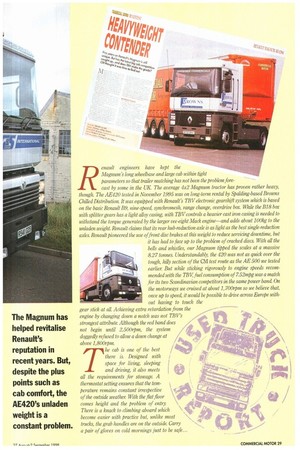
Page 30
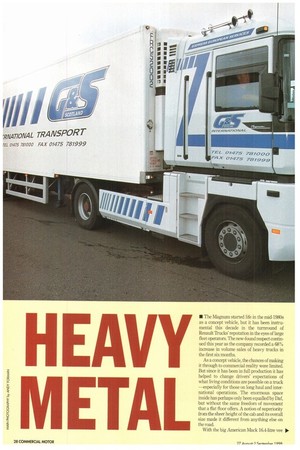
Page 32
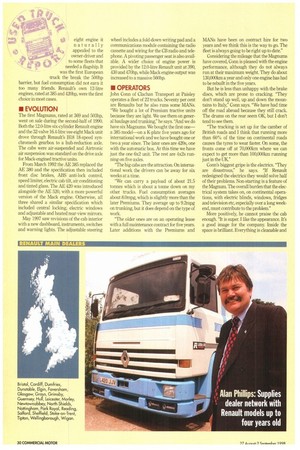
Page 33
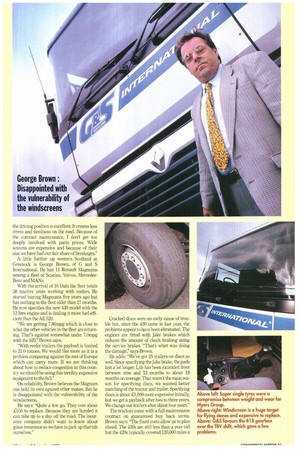
Page 34

Page 35
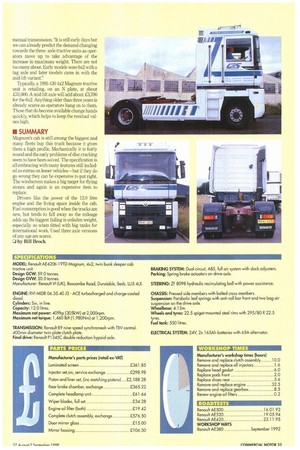
If you've noticed an error in this article please click here to report it so we can fix it.
But, despite the plus points such as cab comfort, the AE420's unladen weight is a constant problem.
• The Magnum started life in the mid-1980s as a concept vehicle, but it has been instrumental this decade in the turnround of Renault Trucks' reputation in the eyes of large fleet operators. The new-found respect continued this year as the company recorded a 68% increase in volume sales of heavy trucks in the first six months.
As a concept vehicle, the chances of making it through to commercial reality were limited. But since it has been in full production it has helped to change drivers' expectations of what living conditions are possible on a truck —especially for those on long haul and international operations. The enormous space inside has perhaps only been equalled by Daf, but without the same freedom of movement that a flat floor offers. A notion of superiority from the sheer height of the cab and its overall size made it different from anything else on the road.
With the big American Mack 16.4-litre veello. enault engineers have kept the Magnum's long wheelbase and large cab within tight parameters so that trailer matching has not been the problem fore
cast by some in the UK. The average 4x2 Magnum tractor has proven rather heavy, though. The AE420 tested in November 1995 was on long-term rental by Spalding-based Browns Chided Distribution. It was equipped with Renault's TBV electronic gearshift system which is based on the basic Renault B9, nine-speed, synchromesh, range change, overdrive box. While the B18 box with sPlitter gears has a light allay casing, with TBV controls a heavier cast iron casing is needed to withstand the torque generated by the larger me-eight Mack engine—and adds about 100kg to the unladen weight. Renault claims that its rear hub-reduction axle is as light as the best single-reduction axles. Renault pioneered the use of front disc brakes at this weight to reduce servicing downtime, but it has had to face uP to the problem of cracked discs. With all the bells and whistles, our Magnum tipped the scales at a massive 8.27 tonnes. Understandably, the 420 was not as quick over the tough, hilly section of the CM test route as the AE 500 we tested earlier But while sticking rigorously to engine speeds recommended with the TBV fuel consumption of 752mpg was a match for its two Scandinavian competitors in the same power band On the motorways we cruised at about 1,700rpm so we believe that, once up to speed, it would be possible to drive across Europe without having to touch the gear stick at all. Achieving extra retardation from the engine by changing down a notch was not TB V's strongest attribute. Although the red band does not begin until 2,500rprn, the system doggedly refused to allow a down change at above 1,800rpm.
The cab is one of the best there is. Designed with
space for living, sleeping and driving, it also meets all the requirements for stowage. A thermostat setting ensures that the temperature remains constant irrespective of the outside weather With the flat floor comes height and the problem of entry. There is a knack to climbing aboard which become easier with practice but, unlike most trucks, the grab handles are on the outside Carry a pair of gloves on cold mornings just to be safe...
eight engine it naturally appealed to the owner-driver and to some fleets that
needed a flagship. It
was the first European truck the break the 500hp barrier, but fuel consumption did not earn it too many friends. Renault's own 12-litre engines, rated at 385 and 420hp, were the first choice in most cases.
_
• EVOLUTION
The first Magnums, rated at 369 and 503hp, went on sale during the second-half of 1990. Both the 12.0-litre six-cylinder Renault engine and the 32-valve 16.4-litre vee-eight Mack unit drove through Renault's 1318 18-speed synchromesh gearbox to a hub-reduction axle. The cabs were air-suspended and Airtronic air suspension was standard on the drive axle for Mack-engined tractive units, From March 1992 the AE 385 replaced the AE 380 and the specification then included front disc brakes, ABS anti-lock control, speed limiter, electric cab tilt, air conditioning and tinted glass. The AE 420 was introduced alongside the AE 520, with a more powerful version of the Mack engine. Otherwise, all three shared a similar specification which included central locking, electric windows and adjustable and heated rear-view mirrors.
May 1997 saw revisions of the cab interior with a new dashboard, instruments, switches and warning lights, The adjustable steering wheel includes a fold-down writing pad and a communications module containing the radio cassette and wiring for the CB radio and telephone. A pivoting passenger seat is also available. A wider choice of engine power is provided by the 12.0-litre Renault unit at 390, 430 and 470hp, while Mack engine output was increased to a massive 560hp.
• OPERATORS
John Conn of Clachan Transport at Paisley operates a fleet of 22 trucks. Seventy per cent are Renaults but he also runs some MANs. "We bought a lot of Premium tractive units because they are light. We use them on general haulage and trunking," he says. And we do have six Magnums. We bought the first one— a 385 model—on a K-plate five years ago for international work and we have bought one or two a year since. The later ones are 420s, one with the automatic box. At this time we have just the one 6x2 unit. The rest are 4x2s running on five axles.
"The big cabs are the attraction. On international work the drivers can be away for six weeks at a time.
"We can carry a payload of about 21.5 tonnes which is about a tonne down on my other trucks. Fuel consumption averages about 8.0mpg, which is slightly more than the later Premiums. They average up to 9.2mpg on trunking, but it does depend on the type of work.
"The older ones are on an operating lease with a full maintenance contract for five years. Later additions with the Premiums and MANs have been on contract hire for two years and we think this is the way to go. The fleet is always going lobe right up to date."
Considering the mileage that the Magnums have covered, Conn is pleased with the engine performance, although they do not always run at their maximum weight. They do about 130,000km a year and only one engine has had to be rebuilt in the five years.
But he is less than unhappy with the brake discs, which are prone to cracking. "They don't stand up well, up and down the mountains to Italy," Conn says. "We have had time off the road abroad because they still crack. The drums on the rear seem OK, but I don't tend to see them.
"The tracking is set up for the camber of British roads and I think that running more than 60% of the time on continental roads causes the tyres to wear faster. On some, the fronts come off at 70,000km where we can expect to get more than 100,000km running just in the UK."
Conn's biggest gripe is the electrics. "They are disastrous," he says. "If Renault redesigned the electrics they would solve half of their problems. Non-starting is a feature of the Magnum. The overall burden that the electrical system takes on, on continental operations, with electric blinds, windows, fridges and television etc, especially over a long weekend, must contribute to the problem."
More positively, he cannot praise the cab enough. "It is super. I like the appearance. It's a good image for the company. Inside the space is brilliant. Everything is cleanable and the driving position is excellent. It creates less stress and tiredness on the road. Because of the contract maintenance, I don't get too deeply involved with parts prices. Wide screens are expensive and because of their size we have had our fair share of breakages."
A little further up western Scotland at Greenock is George Brown, of G and S International. He has 11 Renault Magnums among a fleet of Scanias, Volvos, MercedesBenz and MANs.
With the arrival of 16 Dafs the fleet totals 38 tractive units working with reefers. He started buying Magnums five years ago but has nothing in the fleet older than 21 months. He now specifies the new 430 model with the 12 litre engine and is finding it more fuel-efficient than the AE 520.
We are getting 7.86mpg which is close to what the other vehicles in the fleet are returning. That's against somewhat under 7.0mpg with the 520," Brown says.
"With reefer trailers the payload is limited to 21.0 tonnes. We would like more as it is a problem competing against the rest of Europe which can carry more. If we are thinking about how to reduce congestion in this country we should be using this terribly expensive equipment to the full."
On reliability, Brown believes the Magnum can hold its own against other makes. But he is disappointed with the vulnerability of the windscreens.
He says: ''Quite a few go. They cost about ,£550 to replace. Because they are bonded it can take up to a day off the road. The insurance company didn't want to know about glass insurance so we have to pick up that tab ourselves." Cracked discs were an early cause of trouble but, since the 430 came in last year, the problems appear to have been eliminated. The engines are fitted with Jake brakes which reduces the amount of check braking using the service brakes. "That's what was doing the damage," says Brown.
He adds: "We've got 25 trailers on discs as well. Since specifying the Jake brake, the pads last a lot longer. Life has been extended from between nine and 12 months to about 18 months on average. That wasn't the main reason for specifying discs, we wanted better matching of the tractor and trailer. Specifying discs is about £1,000 more expensive initially, but we get a payback after two to three years. We change our trailers after about four years."
The tractors come with a full maintenance contract on guaranteed buy back terms. Brown says: "The fixed costs allow us to plan ahead. The 430s are still less than a year old but the 420s typically covered 120,000 miles a year. We had one L-reg with TBV, but didn't like it too much.
The gears jammed and the valves were always sticking. The B18 is the box to have, in my opinion. It is a bit clumsy to use but it is very flexible when you get used to it. We have not had any troubles with that box over millions of miles. In fact, we have never had any trouble with the drive line at all; not even the clutch.
"Tyre wear is fairly heavy on the front with the big heavy cab bouncing about. Shoulders wear fairly quickly. Now we run 385 super singles instead of the 295s on the front. They have a bigger foot print so there may be a tendency to understeer on greasy roads, but we haven't experienced that yet. Renault gave them a clean bill of health and the drivers like them. The ride is better and the wheels don't fall in the tyre ruts. Pressures are important; we run them at 130psi to prevent doming. They now last 180,000km instead of 70,00080,000km. We tried 315s initially but the 385s are better. They are easier to get hold of and cheaper.
"The Magnum suits our operation and competes with anything we have. All trucks have their weaknesses. The Magnum has a starting bug but it is not a big problem. It is something in the electrics, but no one has been able to cure it. I have mostly good experiences of Renault's back-up," The Myers Group, based at Purfleet, Essex, ran 36 to 40 Magnums on domestic and international traction contracts from 1994 until last year when Brian Myers retired. Brother Tony, who joined the firm in 1976, has reduced the fleet to a more manageable size and now operates 10 Renault Magnums, collecting and delivering trailers to UK ports.
He says: "We needed four low height tractors with a 1.16m kingpin to run with specia
ist 104m3 'Megacube' trailers for one customer. We wanted them in a hurry and Renault came up with the vehicles in the time frame. Then over a four year period we had 80 units. Some we ran for only a year.
"Obviously we got a good deal on them and the ones we bought new were always with a guaranteed buy-back. Because of the big cab and driver acceptability the residuals are always good.
"We had three Magnums with TBV transmissions. Mechanically they were faultless, but fuel consumption was 1.0mpg heavier than for the manual versions, so they had to go. We didn't buy any more. We now have 420s, mainly Fuel consumption averages out between 8.0mpg and 8.2mpg but we have had more than 10.0mpg on occasions. As they get older economy tends to tail off, even though they are serviced regularly, Our older 385s are returning 7.6mpg.
"They come with a high spec which includes electric blinds and air conditioning, and even a fridge is standard on the 420s. That is good until they go wrong; then the electrics can become expensive to repair. We change the blinds for manual ones when they go wrong. We generally fit the manufacturer's parts, with the exception of brake discs and pads because we can source them for about half the price.
''These days we do not get cracked discs, but we did when they were new. They seemed to be less of a problem if the pads were changed as necessary "There is really only one drawback with the Magnum and that is its tare weight. We bought eight 6x4s units second-hand at a good price. They give us the weight distribution we need, but are slightly unusual as they are equipped with single wheels and run on 315/80s. This brings the unladen weight to within about 200kg of the 4x2 units and that is not so bad; but tyre wear is not very good on the drive axles.
"Because the chassis is long and the tyres are in permanent contact with the road they scrub a lot of rubber off. We only get 120,000kna to 140,000Icm out of them while we can expect anything up to 250,000km, with a cut, from the rear of the 4x2s. We are an allRenault fleet and we are not looking to run anything but Magnums, but when we buy new again we will return to 6x2s."
• INSURANCE
Tony Gardiner, at Roberts and Davis of Newmarket, quoted £974.37 for a mature owner-driver with a full no-claims discount working in the UK. To extend the cover for western Europe nearly doubles the premium to E1,861.99 but the trailer is included under either policy at no extra charge. If the truck is protected by a Tracker or Thatcham CAT 1 security system, it would qualify for a 10% reduction.
• DEALERS
At Dunstable, Alan Phillips is the general manager for Renault's used truck operation which supplies the dealer network with a range of models up to four years old. He says: "The 420 is the most common and the most soughtafter Magnum in the used truck market The 430 came in last year so the only ones I have seen were a couple of factory demonstrators." The 385 was the fleet spec version but it is the full Magnum spec with all of the toys that you get with the 420 4x2 —this is what the used truck customer wants along with the 18-speed
manual transmission. "It is still early days but we can already predict the demand changing towards the threeaxle tractive units as operators move up to take advantage of the increase in maximum weight. There are not too many about. Early models were 6x2 with a tag axle and later models came in with the mid-lift variant."
Typically, a 1995 420 4x2 Magnum tractive unit is retailing, on an N plate, at about .E31,000. A mid-lift axle will add about £3,700 for the 6x2. Anything older than three years is already scarce as operators hang on to them. Those that do become available change hands quickly, which helps to keep the residual values high.
• SUMMARY
Magnum's cab is still among the biggest and many fleets buy this truck because it gives them a high profile. Mechanically it is fairly sound and the early problems of disc cracking seem to have been solved. The specification is all embracing with many features still included as extras on lesser vehicles—but if they do go wrong they can be expensive to put right. The windscreen makes a big target for flying stones and again is an expensive item to replace.
Drivers like the power of the 12.0 litre engine and the living space inside the cab. Fuel consumption is good when the trucks are new, but tends to fall away as the mileage adds up. Its biggest failing is unladen weight, especially so when fitted with big tanks for international work. Used three axle versions of any age are scarce.
17 by Bill Brock SPECIFICATIONS
MODEL: Renault AE420ti-19TD Magnum, 4x2, twin bunk sleeper cob tractive unit.
Design GCW: 59.0 tonnes.
Design GVW: 20.0 tonnes. Manufacturer: Renault VI (UK), Boscomlae Road, Dunstable, Beds. LU5 4LX.
ENGINE: RVI MI DR 06.35.40J3 ACE turbocharged and charge-cooled
diesel.
Cylinders: Six, in line. Capacity: 12.0 litres.
Maximum net power: 409hp (305kW) at 2,000rpm.
Maximum net torque: 1,460 Iloft (1,980Nm) at 1,200rpm.
TRANSMISSION: Renault B9 nine-speed synchromesh with TBV control. 400mm diameter twin plate clutch plate. Final drive: Renault P1345C double reduction hypoid axle. BRAKING SYSTEM: Dual circuit, ABS, full air system with slack adjusters. Parking: Spring brake actuators on drive axle.
STEERING: ZF 8098 hydraulic recirculating ball with power assistance.
CHASSIS: Pressed side members with bolted cross members, Suspension: Parabolic leaf springs with anti-roll bar front and Iwo bag air suspension on the drive axle.
Wheelbase: 4.12m.
Wheels and tyres: 22.5 spigot-mounted steel rims with 295/80 R 22.5
tyres.
Fuel tank: 550 litres.
ELECTRICAL SYSTEM: 24V, 2x 1 65Ah batteries with 65A alternator.
FARTS PRICES
Manufacturer's parts prices (retail ex-VAT}
Laminated screen 2361.85
Injector set,six, service exchange 2298.98 Piston and liner set, (ix matching pistons) ....22,188.28 Rear broke chamber, exchange 2365.22 Complete headlamp unit £61.64 Wiper blades, full set £34.28 Engine oil filter (both) £19.42 Complete clutch assembly, exchange 2576,50 Door mirror glass 215.00 Mirror housing £106.50
WORKSHOP TIMES
Manufacturer's workshop times (hours) Remove and replace clutch assembly 10.0 Remove and replace all injectors 1.6 Replace head gasket 6.0 Replace pads front 2.0 Replace shoes rear 5.6 Remove and replace engine 32.5 Remove and replace gearbox 8.5 Renew engine oil filters 0.2 Renault AE500 16.01.92 Renault AE520 19 05 94 Renault AE420 23.11.95 WORKSHOP WAYS Renault AE380 September 1992
















































































































